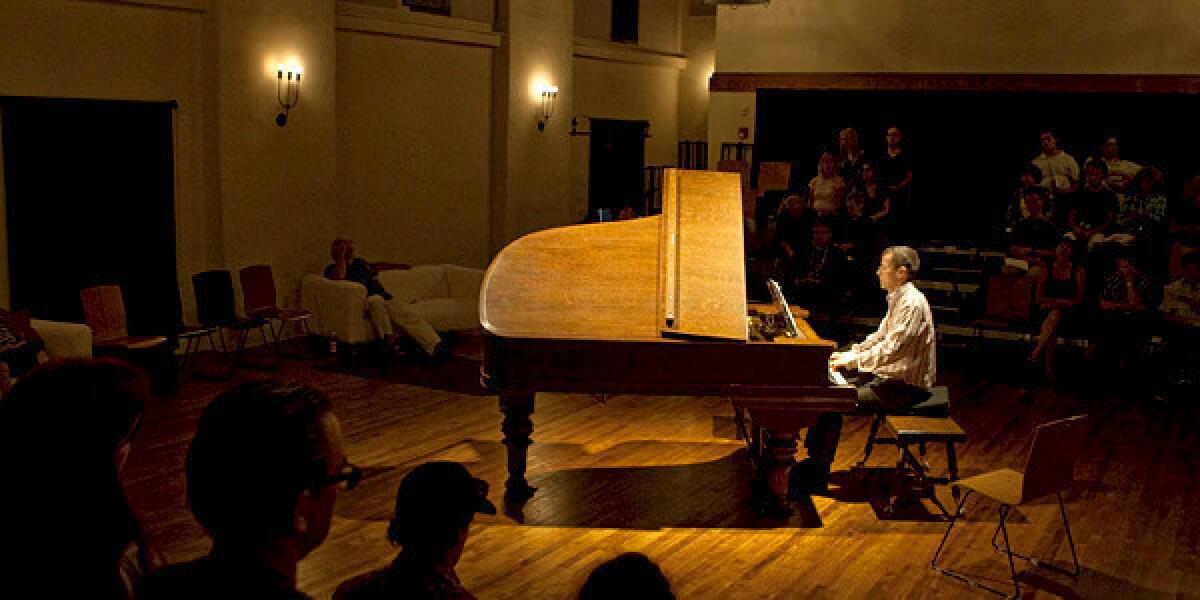Review: John Cage, the Erik Satie connection

- Share via
When it comes to Erik Satie’s “Vexations,” I have thus far been a grazer. On the several opportunities I have had to experience a performance of the work, which entails repeating the same page of mystically unstable music 840 times, a 24-hour proposition give or take a couple of hours depending upon tempo choices, I have always (perhaps conveniently) had obligations keeping me from a full performance of it.
That was the case again for a performance in Santa Monica that began Friday night at 7 and concluded Saturday at 6:56 p.m. Thirty-two pianists were employed, each occupying the piano bench for about 45 minutes. There were, I’m told, always at least three or four listeners in the small Miles Memorial Playhouse in Reed Park. Patrick Scott, the artistic director of Jacaranda who organized the concert as part of Jacaranda’s “Cage 100 Festival” in celebration of the anniversary of the composer’s centenary, sat through the whole thing.
According to John Cage, who organized the first notable performance of the work in New York in 1963, 70 years after Satie wrote it in Paris, the world is different before and after a performance of “Vexations.” It teaches you, Cage discovered, the difference between a concept and an experience.
Story: John Cage’s genuis | Timeline | Music | Critic’s Notebook
A somewhat dazed Scott confirmed that notion when I asked him about it a few minutes after the final chord sounded, and others in the “Vexations” endurance club have said as much. Performances are maybe more common than you would imagine. An hour before the Santa Monica one ended, another had begun in Berkeley.
We guard our time jealously, but Cage organized the “Vexations” marathon (12 pianists — one was John Cale from the Velvet Underground — played in that early performance and the New York Times sent a tag team of critics, one of whom was drafted to perform) with the alarming proposition that we should not. “Why are we so stingy,” he asked, “about time? What, for heaven sakes, is so precious about a half hour, an hour, an hour and a half?” Giving up ownership of time, Cage asserted, opens us to new experience.
Still, my time Friday and Saturday was divided. I dropped into the Miles Playhouse Friday night after having attended Long Beach Opera’s U.S. premiere of Gavin Bryars’ “The Paper Nautilus.” By chance, Bryars happens to be a British minimalist composer who performed a complete “Vexations” in London in 1970 with one other pianist, and he credits that with influencing what became his own enthrallingly repetitive, meditative musical style.
Story: John Cage’s genuis | Timeline | Music | Critic’s Notebook
Satie gives little indication of how “Vexations” should be played, and the pianists I heard during my three visits were varied. Mark Menzies on Saturday morning was very slow and uninflected. Mark Alan Hilt on Saturday afternoon gave a different personality to each repetition, making a drama of the work.
But somehow that made little difference. “Vexations” has the capacity to create the sensation of well-being, the awareness of continuity of time as a physical flowing substance.
The Cage festival continued shortly after “Vexations” concluded at the nearby Santa Monica Bay Woman’s Club, where the composer had given his first concert in the early ‘30s. After a talk by Eric Smigel about the process through which Cage began the removal of his ego from his music, Aron Kallay performed “The Perilous Night” for prepared piano, a 1944 work of roiling expression written during the dark war years and when Cage’s marriage was coming unraveled.
Story: John Cage’s genuis | Timeline | Music | Critic’s Notebook
The main event was what was billed as the first performance of Cage’s “The Ten Thousand Things.” Five solo pieces with impossible time lengths as titles (such as “26’1.1449” “ for a string player) are written in graphic notation meant to keep performers open to the possibility of new discoveries.
Cage allows for performing all simultaneously, which apparently had never been done before live (they’ve been recorded), although a short one (“59½” “ for a string player) fell through the cracks. The performers — pianists Vicki Ray and Kallay, bassist Tom Peters, percussionist William Winant and reciter John Schneider were exquisite. Every sound sounded considered, alive, worthy of our wonder.
Sunday afternoon at the Annenberg Community Beach House Adam Tendler presented Cage’s hour-long “Sonatas and Interludes” for prepared piano, widely considered the composer’s first masterpiece. He wrote the Sonatas and Interludes in the late ‘40s at the time he discovered a manuscript of the neglected “Vexations” and began in this luminous score the process of stripping predetermined expression from his music in the search for tranquillity.
Story: John Cage’s genuis | Timeline | Music | Critic’s Notebook
An exuberantly expressive pianist, Tendler vividly displayed his enthusiasm for every phrase by attempting to stop and start time at will. When he learns to let the music sparkle on its own, as the marvelous performers had the night before, he will become a fine Cage pianist.
Tendler had been the first of the “Vexations” pianists Friday night. Clearly 45 minutes with Satie’s miraculous score is too little exposure for any of us.
MORE:
CRITIC’S PICKS: Fall Arts Preview
TIMELINE: John Cage’s Los Angeles
More to Read
The biggest entertainment stories
Get our big stories about Hollywood, film, television, music, arts, culture and more right in your inbox as soon as they publish.
You may occasionally receive promotional content from the Los Angeles Times.











